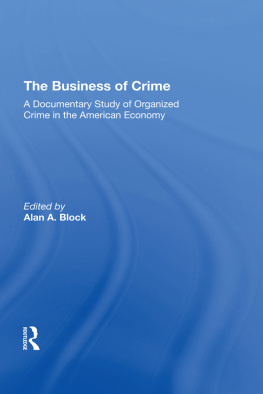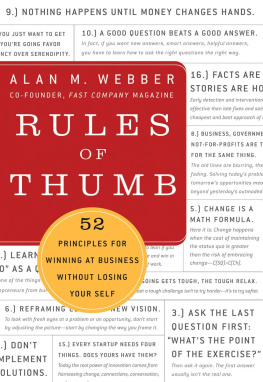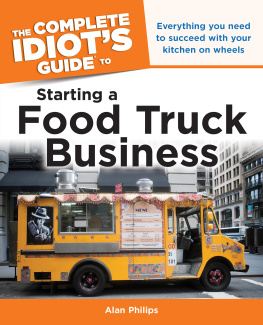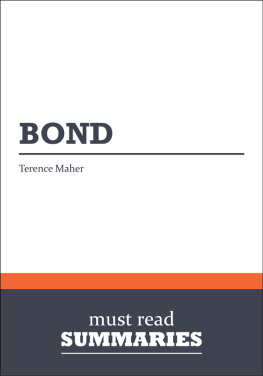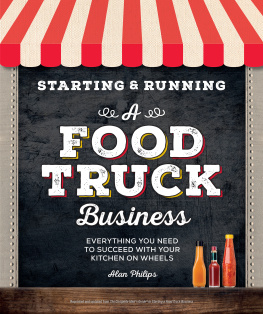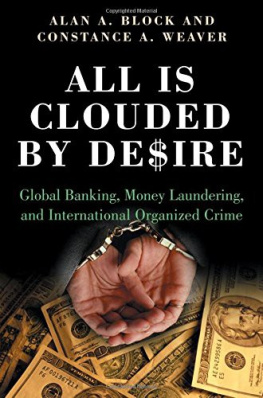First published 1991 by Westview Press
Published 2019 by Routledge
52 Vanderbilt Avenue, New York, NY 10017
2 Park Square, Milton Park, Abingdon, Oxon OX14 4RN
Routledge is an imprint of the Taylor & Francis Group, an informa business
Copyright 1991 Taylor & Francis
All rights reserved. No part of this book may be reprinted or reproduced or utilised in any form or by any electronic, mechanical, or other means, now known or hereafter invented, including photocopying and recording, or in any information storage or retrieval system, without permission in writing from the publishers.
Notice:
Product or corporate names may be trademarks or registered trademarks, and are used only for identification and explanation without intent to infringe.
Library of Congress Cataloging-in-Publication Data
Block, Alan A.
The business of crime : a documentary study of organized crime in
the American economy / Alan A. Block.
p. cm.
Includes index.
1. Organized crimeEconomic aspectsUnited States. 2. Business
United StatesCorrupt practices. I. Title.
HV6448.B55 1991
364.1060973dc20
90-43498
CIP
ISBN 13: 978-0-367-29049-8 (hbk)
The idea for this book came while I was teaching a graduate seminar on organized crime, part of my departments new graduate program in the administration of justice. I was determined to find a work that would both summarize relevant material on the organization of crime as well as introduce students to various kinds of readily available data dealing with organized crime, particularly its entrepreneurial expressions. The task stymied me. There are, of course, numerous excellent monographs on different aspects of organized crime but none that explicitly fulfill my dual purposes. That frustration and the sympathetic ear of Spencer Carr, senior editor at Westview Press, led to this book.
In all my work at The Pennsylvania State University, I have received ample support from Daniel Maier-Katkin, chair of the Department of Administration of Justice. It is he who supplied the critical material necessary for contemporary scholarship and created the environment essential for reflection and writing. My debt to Daniel grows year by year; it is starting to worry me. The departments senior secretary as well as my friend, Melody Lane, typed the manuscript with her usual skill and breakneck speed. Her dependability at meeting even the harshest deadlines is unsurpassed.
Because of the genesis and purpose behind The Business of Crime , I would like to dedicate it to that first class of graduate students, especially the indefatigable Lisa Vardzel.
Alan A. Block
1
Introduction: The Business of Organized Crime
The presence of organized crime in the U.S. industrial economy is undeniable. This book presents primary evidence of this association through an assortment of government documents generated in the past three decades. These edited records form the heart of this work, and I intend to let them speak mostly for themselves. By doing so, I hope to introduce students to the rich cache of material on organized crime available in the government (state and federal) documents section of research libraries, in the libraries and archives of state capitals, and in easily available court documents. Although two complementary purposes--intellectual and pedagogical--are sufficient to warrant this book, I also wish to advance some propositions concerning the interplay of organized crime and U.S. economic institutions in order to provide a context for the documents Ive chosen.
I have always believed--along with many others--that organized crime is completely enmeshed within the U.S. industrial economy. It is not some sort of peripheral aberration but exerts a force within the many layers of industry. Apocryphal statements attributed to racketeers, such as We are bigger than General Motors, signify a giant, cohesive organized-crime conspiracy. In fact, leaving aside for the moment the questions of size and overall influence, it has been shown that organized criminals did work closely with one American car giant. This was the Ford Motor Company, whose contact with the underworld was engineered by Fords security chief, Harry Bennett. Always acting with Henry Fords blessing, Bennett positively revelled in making personal contact with the underworld, [his] memoirs are a boastful catalogue of the murderers, racketeers, and extortionists whose friendship he purchased with the funds and influence of the Ford Motor Company. Among the friends he cultivated was Chester LaMare, a bootlegger and killer who led an important Italian-American gang in Detroit. Bennett gave Crescent Motor Sales, a Ford agency, to LaMare and also granted the racketeer an exclusive franchise to supply fruit to the lunch stands and canteens in Ford plants.
Mobster control of Ford agencies and distributorships long outlived the violent union-management battles of the 1930s. Professional criminals seek economic opportunities in the same arenas as do many others. Moreover, their typical lack of restraint may be their most appealing quality to those, like Ford and Bennett, who were helped by their violence against unions and were also excited by it.
The involvement of organized criminals in businesses large and small has been noted time and again. Add to garment manufacturing the construction and waterfront industries, food distribution, and at least one form of public transportation, to judge just how fully integrated organized crime and the citys economy had become.
If New York in 1930 seems too far removed from the present, then regard the data provided in the fall of 1963 by the Senates Permanent Subcommittee on Investigations, in the full flush of its Mafia counting following the supposed revelations of mob informant Joseph Valachi. The appendix to the hearing record on Organized Crime and Illicit Traffic in Narcotics lists infiltrated firms in finance, waste disposal, food, construction, insurance, liquor, vending, jukeboxes, and several others.the Mafia. Bars, restaurants, real estate companies, bakeries, motels, a barber college, construction firms, metal finishers, tool and die companies, cleaners, food wholesalers, farms, insurance agencies, race tracks, truck companies, warehouses, paving and steel firms, car washes, office buildings, and many other types of enterprises were catalogued from information gathered by the Criminal Information Bureau of the Detroit Police Department.
On the New York waterfront, organized crimes control of the port was manifested through its control of the International Longshoremens Association (the nations primary waterfront labor union), several score private businesses, and the major shipping and stevedore companies. For instance, in the 1950s, organized crime chieftain Vito Genovese bought a 49 percent interest for $245 in the waterfront firm Erb Strapping, which straps cargo, that is, the placing of steel straps traveling aboard ship, a service incidental to the movement of waterborne freight.
In the mid-1960s, Erb Strappings insurance business was turned over to a new company owned by the son of a prominent mobster very closely associated with Genovese. Further investigations by the Waterfront Commission (itself created to combat the racketeers domination of the port) revealed that a Genovese partner, Peter DeFeo, apparently controlled the house trucker at Pier 13, East River, New York City, and at Port Newark. This outfit had a monopoly in the trucking of bananas imported into New York City and consigned to jobbers within a 50 mile radius of New York City and somewhat farther on Long Island.

